As an Amazon Associate I earn from qualifying purchases.
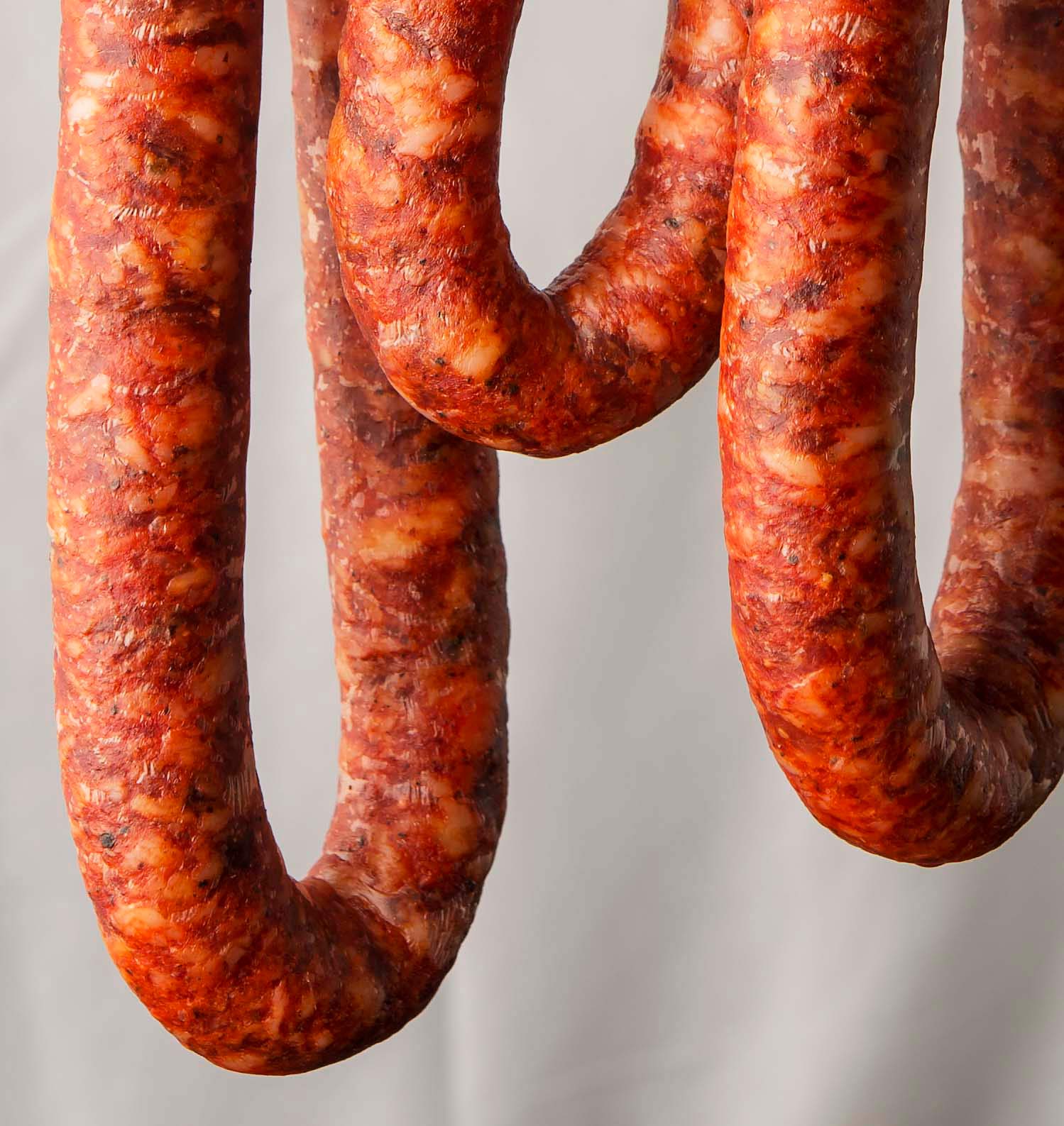
Longaniza is chorizo’s lesser known cousin.
They are similar sausages, often red with chiles, paprika or annatto (achiote), sometimes spicy, sometimes not, sometimes with vinegar, sometimes just some citrus juice. Always garlic. Lots of garlic.
So as you can see, coming up with the One True Longaniza is a fool’s errand, because not only do many countries have their own versions, many countries’ versions vary from place to place within their own borders. If you want to read more on it, here’s the Wikipedia article.
This longaniza recipe is from Mexico, from the state of Tabasco, to be specific.
I’ve cobbled it together from several sources, ranging from Diana Kennedy’s books to a Spanish language cookbook focusing on Tabasco to the late David Sterling’s phenomenal book Yucatán: Recipes from a Culinary Expedition, which includes a smoked version from Valladolid.
The presence of achiote paste and Seville orange juice makes this longanzia southern Mexican. They sound more exotic than they are. You can buy both in most Latin markets all over the United States. Look for achiote rojo, and get the bigger block, and jugo de naranja agria. Both will be shelf stable.
You can also buy sour orange juice and achiote paste
online. Or you can make a good Seville orange substitute by juicing an orange and two limes and mixing them.
Oh, and you will notice that I use something called C-Bind. It’s carrot fiber, and it helps a sausage retain moisture. A little bit added to the mixture helps a lot!
The result is a fantastically exotic sausage that isn’t spicy. Of course, you can add hot chiles if you want. I like these grilled and served alongside various other Mexican grilled things, like flank steak. Uncased, longaniza makes a spectacular filling for Mexican empanadas, or mixed with eggs and stale tortillas for chilaquiles.
Really longaniza can be used in any way you’d use regular chorizo. And if you want to make your own regular chorizo, I have that recipe, too. You can also make this as a cured salami.
Mexican Longaniza
Ingredients
- 5 pounds fatty pork shoulder
- 34 grams sea salt or kosher salt, about 2 tablespoons
- 2 heads garlic, peeled and chopped (yes, two heads)
- 1 tablespoon freshly ground black pepper
- 1 teaspoon ground cumin
- 3 tablespoons achiote paste
- 1/2 cup Seville orange juice (see above)
- 1 teaspoon C-Bind carrot fiber (optional)
- Sheep casings (see above)
Instructions
- Cut the pork shoulder into chunks that will fit into your grinder. Mix this with the salt, chopped garlic, pepper and cumin, and refrigerate overnight, or up to 2 days. You can skip this step, but your sausage will not bind as well.
- Get out about 15 feet of sheep casings and soak them in warm water. If you want, flush them with water; this helps the stuffing process and will let you know if you have any leaks.
- Grind the meat through a medium (6.5 mm) die. Chill the mixture in the freezer until it is about 33 degrees Fahrenheit.
- When the mixture is cold enough, mix the achiote paste and the orange juice together, then mix that into the meat along with the carrot fiber, if using. Mix well with your (very clean) hands for 60 to 90 seconds. Your hands will ache with cold. You'll know the sausage is ready when it coheres in one mass. You'll also start to see whitish streaks form on the side of the container you're mixing in. You can also do this mixing in a stand mixer on low.
- Pack your sausage into a stuffer and thread on a length of casing. Slowly ratchet down the meat to remove all air from the stuffer and the tube the casing is on. Leave about 4 inches of casing off the end of the tube; you'll use this to tie off later.
- Stuff about 2 feet of sausage rather loosely, leaving a couple inches of casing on either end. Do this with all the sausage and casings. When you have all the sausage in these lengths, gently compress each one looking for air pockets. Use a needle or sausage pricker to pop any air pockets. Gently compress the links to fill that gap. This takes finesse not to burst the casing.
- When all you links are ready, tie the ends to each other to form an elongated loop. Hang your longaniza to dry. At room temperature, hang an hour or two. Ideally, you'll hang links between 33 and 39 degrees Fahrenheit for 24 hours, or even up to 3 days. Barring that, leave them uncovered in the fridge overnight before eating or freezing.
Notes
Nutrition
Nutrition information is automatically calculated, so should only be used as an approximation.

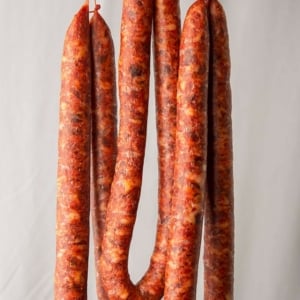

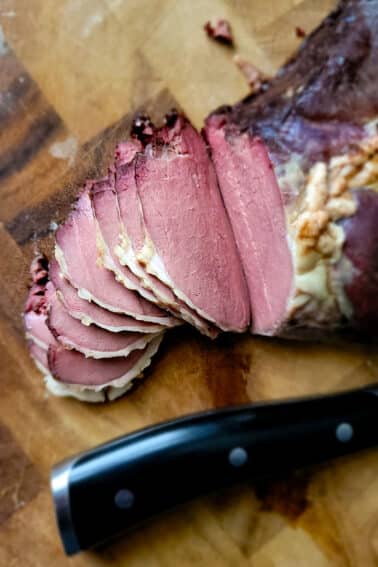
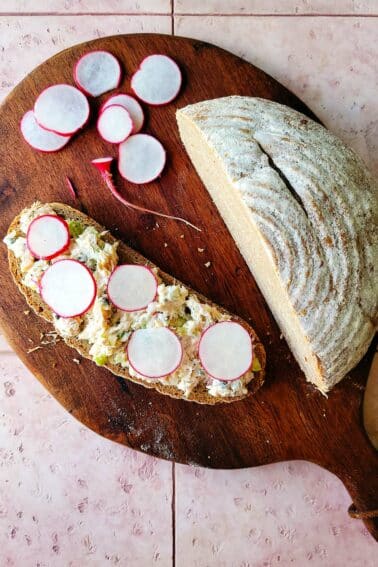
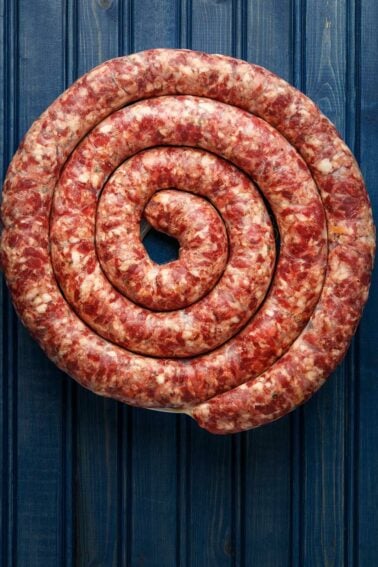
Regarding the Longaniza sausage. It lacks any curing salt if a person is going to smoke it. Should it not have curing salt?
I can see yes if it is a fresh sausage.
hey, this changed from Spanish to Mexican longaniza. I think the Spanish was a better sausage. Any way to get a copy of that recipe?
Scott: You are mistaken. I never had a Spanish longaniza recipe. I have other Spanish sausage recipes, though.
if I wanted to make this hotter. is there some guide for how much chili pepper flakes in 5 lbs would give a mild to hot sausage?
James: Hard to say. But a tablespoon of flakes will make it hotter.
A good recipe to add is Philippine Longanisa. The two popular ones are Vigan and Pampanga. Vigan is the sour kind while Pampanga is sweet.
Hank, help! I swear you had a Spanish Loganiza recipe a few years back. It had lots of paprika, rosemary and red wine vinegar. Maybe I’m misrembering. Got to whip some up this weekend to use in the annual paella at Burningman next week. I may have to wing it.
HELP! I swear your Longaniza recipe used to be for Spanish style, with paprika, rosemary and red wine vinegar. I’ve made it for many years to put in my paella. I have always make a big batch of paella (Playella) at Burningman for the last 9 years. Am I missremebering? Got to get sausage going tomorrow, so I’ll have to wing it, but hope you put that recipe back up, unless I’m totaly confused and its not yours. LOve the site!
Hi hank thx for the recipe. Just a quick question, I’m a little confused, is this a sausage that requires cooking or is it a semi dried sausage similar to a landjaeger? Because it sounds similar to a landjaeger
Dyllan: No, this requires cooking. Landjaeger is cured and smoked and hung much much longer. This one only hangs for one day, max.
I should have prefaced my previous comment with “I have been making Andouille for a year or more now from your recipe. I use it in gumbo, dice it in scrambled eggs and dutch oven breakfast casseroles while camping, and eat it like a hot dog with Zatarains Creole Mustard. I and my friends and family love it!”
Hi Hank, I sent you a message earlier today. I’m new to the whole comuter communication. You had replied back and I was interested in your responce but before I could write out what you said, I some how lost the page that your reply was on. Could you please re-send me your reply again.
The topic/question was regarding “sausages and carcinogens”
May 20th @ 5am
Sorry about that,
Kathryn
Hank,
Why doesn’t this recipe call for pink salt, like your Andouille recipe does? IT makes a fairly strong case that pink salt is needed for sausages like these.
Al: Because it isn’t really needed, especially if you don’t smoke it. If you are smoking your sausage and want to add some, use 3 to 5 grams.
Awesome job Hank, have been looking for an authentic longaniza recipe for some time now. Can’t wait to make it
First of all “your amazing” – I bought all your books and am waiting for your next book (Everything Fish). But I do have a question re: sausage – I’ve come across articles a few times now, that cured/ smoked meats, sausage’s, ham,bacon are Carcinogens. What’s your opinion on that ?
Thank you for sharing your passion and knowledge
Sincerely, Kathryn
First of all “your amazing” – I bought all your books and am waiting for your next book (Everything Fish). But I do have a question re: sausage – I’ve come across articles a few times now, that cured/ smoked meats, sausage’s, ham,bacon are Carcinogens. What’s your opinion on that ?
Thank you for sharing your passion and knowledge
Sincerely, Kathryn
Kathryn: It’s simply not true for the way most people eat cured meat. Yes, if you eat lots and lots and lots of cured meat, there is a correlation – not a causation – connected to the amount of nitrite in them. But remember that there is more nitrite in celery and some other leafy greens, and also remember that as with everything in this world, including water, the poison is in the dose. We eat cured meats here and there, and are fine. If your diet centered on cured meats? You might – might- be in a different situation.
Hank,
Great recipe. I’ve made these sausages from other formulations, and look forward to trying this one.